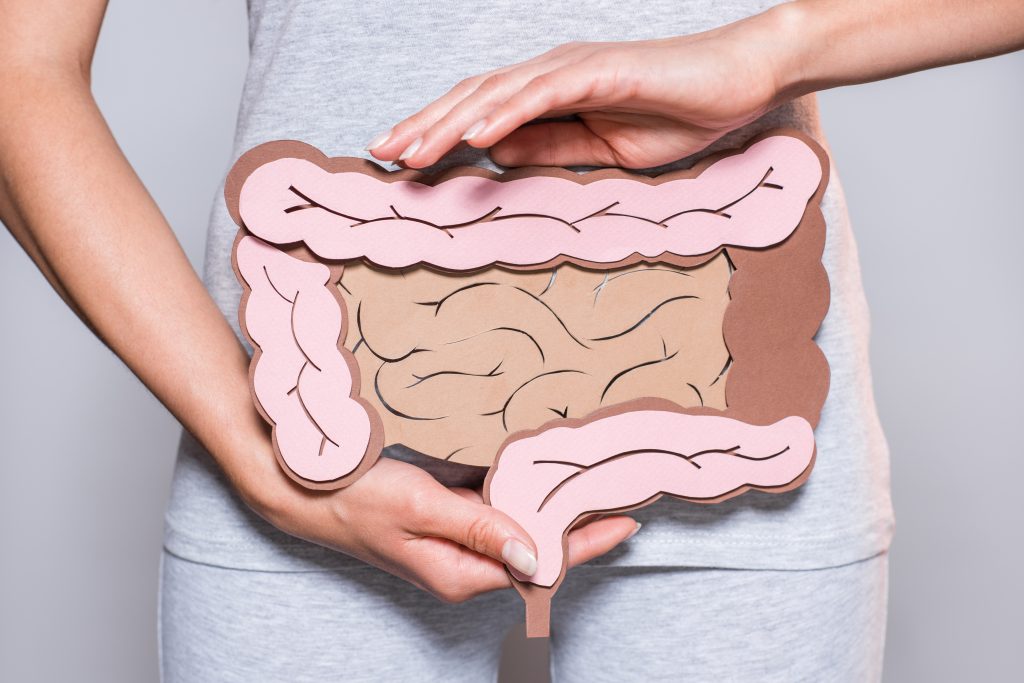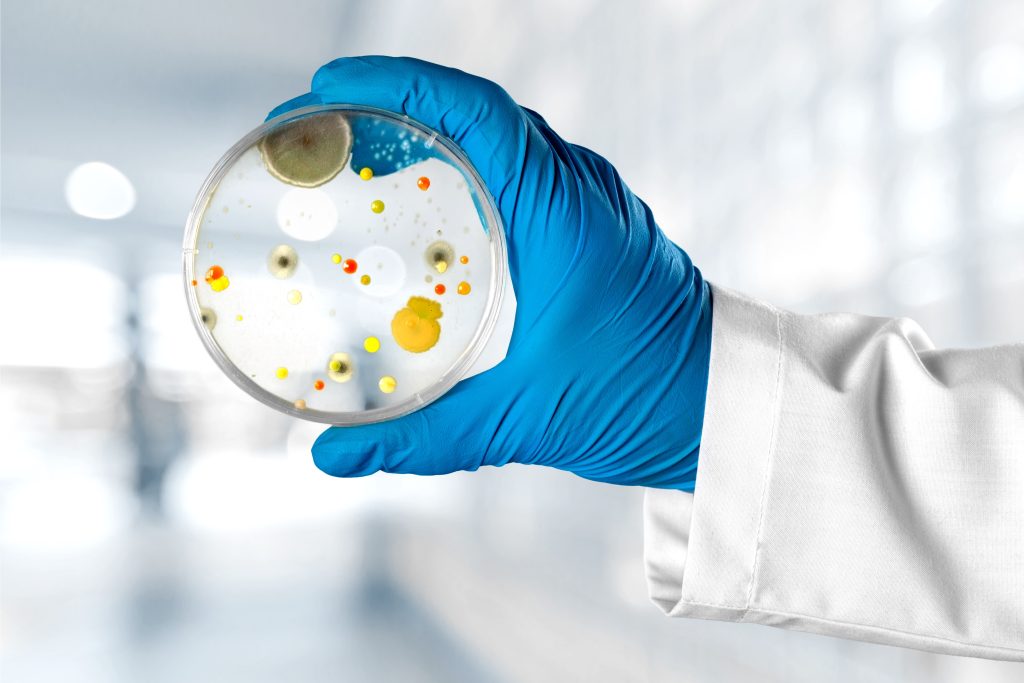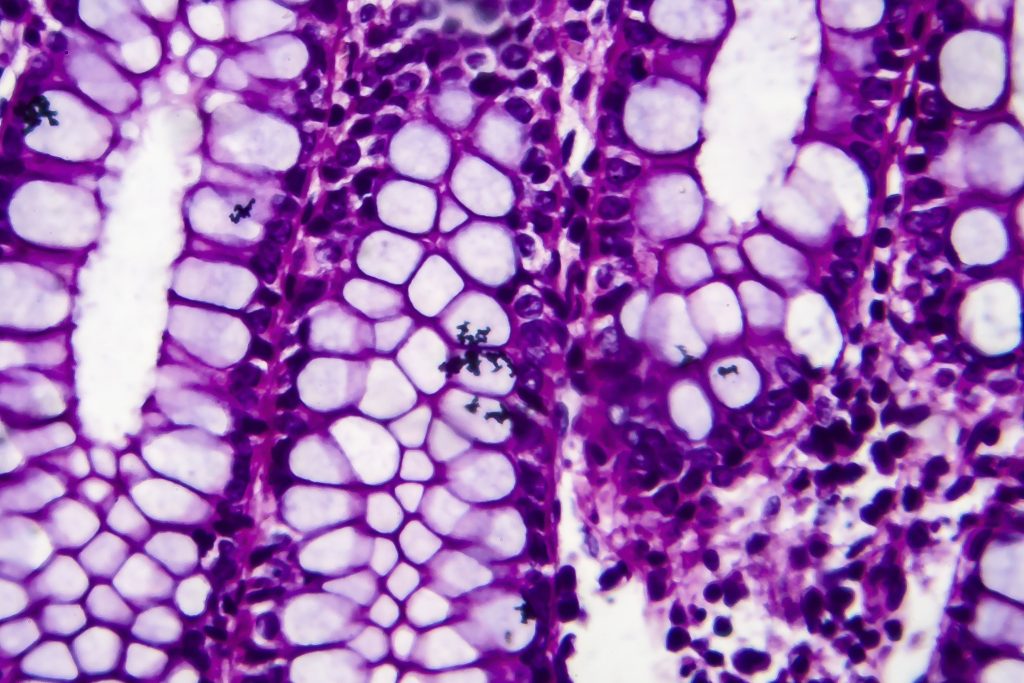Professor Hervé Agaisse | A New Model to Understand Shigellosis Infection
Shigella flexneri is a species of bacteria that causes approximately 270 million cases of Shigellosis (bacillary dysentery) each year, resulting in more than 200,000 deaths worldwide. Professor Hervé Agaisse and his team, based at the University of Virginia, USA, have proposed a new model of the disease. By adopting a multidisciplinary approach, they have recapitulated the symptoms caused by Shigella flexneri in the laboratory, enabling them to determine more precisely how these bacteria cause disease.
Bacillary Dysentery: Causes and Treatment
Bacillary dysentery is a severe gastrointestinal disease caused by the rod-shaped bacterium Shigella flexneri. It causes approximately 270 million cases of disease and over 200,000 deaths worldwide each year. Children aged under five and living in developing countries are sadly over-represented in these statistics.
The disease is characterised by profuse bloody diarrhoea and dramatic ulceration of the colon surface, the longest part of the large intestine. The bacteria are transmitted via the faecal–oral route – meaning it is transmitted from the stools of an infected person to the mouth of another, most often through contaminated water, hands or food.
Bacillary dysentery is extremely contagious. It replicates within human colon cells and spreads throughout the colon, leading to massive tissue destruction. The cellular and molecular mechanisms underlying the infection process in an individual are currently still not fully understood. However, the increasing and alarming presence of Shigella flexneri strains that are resistant to multiple antibiotics has generated urgency for a better understanding of how this particular pathogen causes disease in humans.
During infection, Shigella flexneri invades the cells which line the surface of the colon. The bacteria then hijack the host cell actin cytoskeleton, which is a microscopic network that determines cell shape and motility (movement), to move within cytosol, a fluid found inside living cells. The bacteria spread from cell to cell through the formation of ‘fingerlike’ membrane protrusions which project into adjacent cells.
Upon spreading from one cell to another via these protrusions, the bacteria are entrapped in cell membrane compartments termed ‘double membrane vacuoles’. These are composed of an inner membrane, originating from the primary infected cell, and an outer membrane deriving from the adjacent cell. By escaping the double membrane vacuoles, Shigella flexneri gains access to the adjacent cells and thus achieves its spread. Initial invasion of epithelial (surface) cells such as those in the colon and then the cell-to-cell spread are both critical determinants of disease development.
Compared to the mechanisms supporting actin-based motility of Shigella flexneri, the mechanisms underlying cell-to-cell spread have received less attention. Professor Hervé Agaisse and his team, based at the University of Virginia in the USA, set out to understand this process more fully through the development of a novel animal model.
The model developed by Professor Agaisse is the first to recapitulate symptoms of human disease caused by Shigella flexneri, representing a significant advancement in the field. Their recent research has looked at the Shigella ‘effectors’ – the secreted proteins produced by the pathogenic bacteria that manipulate the host cell during infection. Using a multidisciplinary approach, Professor Agaisse’s laboratory has investigated how both the bacterial and those host factors that are hijacked are required for this infection process. This vital work has provided us with a much better understanding of how the pathogen operates.

Development of a Novel Animal Model
The use of in vitro tissue culture systems where cells or fragments of tissue from an animal are grown in the laboratory has been instrumental in defining the molecular mechanisms supporting the invasion of Shigella flexneri into cells.
This research led to the discovery that Shigella flexneri invasion relies on the presence of a particular ‘invasion plasmid’, a small circular DNA strand encoding the bacterial type-3 secretion system. The type-3 secretion is a microscopic needle that Shigella flexneri uses to ‘inject’ its proteins into host cells.
Bacterial effector proteins, which are delivered into targeted host cells by the secretion system manipulate various cellular processes, including the actin cytoskeleton, leading to the uptake of the bacteria into compartments made of host cell membrane termed primary vacuoles. Escape from primary vacuoles allows the pathogen access to the host cell cytosol. Cytosolic bacteria express a protein known as ‘IcsA’ which is involved in the recruitment of the host cell actin assembly machinery at the bacterial pole. This process of actin polymerisation propels the pathogen throughout the cytosol of infected cells, which ultimately enables cell-to-cell spread into adjacent cells.
There is a significant gap in knowledge as to how the biology of Shigella flexneri infection relates to the development of the disease in its human hosts. This is partly due to the lack of small-animal models of bacillary dysentery. Shigella flexneri is a human-specific pathogen and the only known animals that display the symptoms observed in infected humans are other non-human primates. Various small-animal models have been developed and used in the past, but unfortunately, most of these models are not relevant to the site of Shigella flexneri infection in humans – the colon.
Furthermore, none of these models can recapitulate bloody diarrhoea, the hallmark of human Shigellosis. Professor Agaisse and his team, therefore, developed an infant rabbit model of bacillary dysentery that recapitulates all the symptoms of human shigellosis. They used it to explore the role of bacterial factors which were critical to intracellular infection in tissue culture systems, including the type-3 secretion system and the dissemination factor IcsA.
Remarkably, despite the early signs of immune cell infiltration and vascular lesions, the animals infected with bacteria lacking IcsA did not experience any signs of bloody diarrhoea or related weight loss. This infant rabbit model highlights the critical role that cell-to-cell spread plays in causing bacillary dysentery. Targeting cellular mechanisms that support Shigella flexneri spread from cell to cell may therefore represent a promising medical prevention. As such, the infant rabbit model provides an unprecedented framework for understanding how the biology of Shigella flexneri infection relates to the development of disease in humans.

The Art of Manipulation
As the researchers demonstrated using the infant rabbit model, the ability of Shigella flexneri to spread from the initially infected colon cell to neighbouring cells is essential for disease symptoms to develop. Professor Agaisse and his team investigated the cellular and molecular mechanisms of how Shigella manipulates the host cell during an infection, and thus allows cell-to-cell spread.
Shigella flexneri spreads within the colon by displaying actin-based motility in the cytosol of epithelial cells. Motile bacteria form membrane protrusions that project into adjacent cells and resolve into double-membrane vacuoles from which the bacteria escape, thereby achieving cell-to-cell spread. Once it’s entered a cell, Shigella flexneri is targeted by a type of autophagy, a host cell defence mechanism used to fight intracellular pathogens.
It was proposed that an effector protein called ‘IcsB’ produced by the bacteria is responsible for counteracting the recruitment of a type of autophagy machinery to bacteria located in the cytosol. However, a more recent study proposed that this autophagy machinery was instead recruited to bacteria located in double membrane vacuoles formed during cell-to-cell spread. To clarify the role that autophagy plays in managing Shigella flexneri infection, Professor Agaisse and Dr Erin Weddle looked at bacterial spread using a special type of microscopy and determined the spatial and temporal recruitment of autophagy machinery in response to the presence of Shigella flexneri bacteria.
Their results demonstrated without doubt that IcsB produced by the bacteria is required for double membrane vacuole escape during cell-to-cell spread, regardless of autophagy machinery recruitment by the host cell, providing a direct challenge to the previously proposed theory that autophagy combats Shigella flexneri spread.
Professor Agaisse and Dr Weddle also characterised another effector protein called ‘IpgB1’. This is produced by Shigella flexneri and allows the bacteria to spread throughout the human colon. The researchers discovered that IpgB1 manipulates host cell signalling proteins to escape the double membrane vacuoles and spread throughout the colon. In another recent study, Professor Agaisse and Dr Volkan Köseoğlu showed that Shigella flexneri employs the activity of another effector protein called ‘IpgD’ to manipulate a type of lipid molecule that is found in the protrusion membrane. This affects the formation of actin networks underneath the protrusion membrane, which would otherwise prevent the stepwise progression of protrusions into double-membrane vacuoles during cell-to-cell spread.
Using their rabbit model, the researchers also demonstrated that the bacterial effectors IpgB1 and IpgD are required for efficient dissemination in the colon of infant rabbits and contribute to the severity of disease. Together, these studies converge to illustrate how Shigella effectors can manipulate the host cell during infection and allow for cell-to-cell spread.

Implications for Therapeutic Development
The team’s work has provided a unique small-animal model that will facilitate further research and the development of therapeutic interventions against Shigella flexneri infections. The lack of an effective vaccine and the presence of Shigella strains that are resistant to multiple antibiotics has generated urgency for an increased understanding of how this particular pathogen operates. Professor Agaisse’s work provides insight into the mechanisms by which Shigella flexneri causes disease and suggests several novel therapeutic targets. Targeting the bacterial and cellular mechanisms that support Shigella flexneri spread from cell to cell may represent promising a method for reducing cases of bacillary dysentery in humans.
SHARE
DOWNLOAD E-BOOK
REFERENCE
https://doi.org/10.33548/SCIENTIA910
MEET THE RESEARCHER

Professor Hervé Agaisse
School of Medicine
University of Virginia
Charlottesville, VA
USA
Professor Hervé Agaisse obtained his PhD at the Pasteur Institute in Paris and then completed postdoctoral training at Harvard Medical School, USA, between 1998 and 2004. In 2005, he set up a laboratory at Yale University, working to systematically identify host genes supporting the dissemination of intracellular pathogens. In 2015, Professor Agaisse joined the University of Virginia, where his current research focuses on the molecular and cellular mechanisms involved in Shigella flexneri infection in tissue culture systems and newly developed small-animal models of bacillary dysentery. The Agaisse Laboratory is committed to the development of therapeutic interventions to overcome the challenges of bacterial disease. To this end, Professor Agaisse and his team utilise a multi-disciplinary approach integrating molecular and cellular microbiology, bacterial and host cell genomics, bioinformatics, and unique animal models of pathogenesis.
CONTACT
E: hfa5y@virginia.edu
W: https://med.virginia.edu/faculty/faculty-listing/hfa5y/
https://mic.med.virginia.edu/agaisse/
KEY COLLABORATORS
Dr Erin Weddle, University of Virginia, USA
Dr Volkan K. Köseoğlu, Wake Forest University, USA
FUNDING
National Institutes of Health/National Institute of Allergy and Infectious Diseases
FURTHER READING
EA Weddle, VK Köseoğlu, BA DeVasure, HF Agaisse, The type three secretion system effector protein IpgB1 promotes Shigella flexneri cell-to-cell spread through double-membrane vacuole escape, PLoS Pathogens, 2022, 18(2), e1010380. DOI: https://doi.org/10.1371/journal.ppat.1010380
VK Köseoğlu, MK Jones, H Agaisse, The type 3 secretion effector IpgD promotes S. flexneri dissemination, PLoS Pathogens, 2022, 18(2), e1010324. DOI: https://doi.org/10.1371/journal.ppat.1010324
LK Yum, H Agaisse, Mechanisms of bacillary dysentery: lessons learnt from infant rabbits, 2020, Gut Microbes, 11(3), 597–602. DOI: https://doi.org/10.1080/19490976.2019.1667726
LK, Yum, MX Byndloss, SH Feldman, H Agaisse, Critical role of bacterial dissemination in an infant rabbit model of bacillary dysentery, Nature Communications, 2019, 10, 1826. DOI: https://doi.org/10.1038/s41467-019-09808-4
E Weddle, H Agaisse, Spatial, Temporal, and Functional Assessment of LC3-Dependent Autophagy in Shigella flexneri Dissemination, Infection and immunity, 2018, 86(8), e00134–18. DOI: https://doi.org/10.1128/IAI.00134-18

REPUBLISH OUR ARTICLES
We encourage all formats of sharing and republishing of our articles. Whether you want to host on your website, publication or blog, we welcome this. Find out more
Creative Commons Licence (CC BY 4.0)
This work is licensed under a Creative Commons Attribution 4.0 International License. 
What does this mean?
Share: You can copy and redistribute the material in any medium or format
Adapt: You can change, and build upon the material for any purpose, even commercially.
Credit: You must give appropriate credit, provide a link to the license, and indicate if changes were made.
SUBSCRIBE NOW
Follow Us
MORE ARTICLES YOU MAY LIKE
Dr Ralf Adam | New Technologies Shaping the Future of Oral Hygiene
Understanding the efficiency of various toothbrush technologies is essential for achieving optimal oral health. Dr Ralf Adam, who leads a dedicated team at Procter & Gamble in Germany, is keen to investigate the complexities of these technologies. His team have provided new insights into the best toothbrush types for plaque removal and the maintenance of gum health. By highlighting the importance of informed oral care decisions and ongoing investigations, this vital research works towards ensuring everyone can achieve a brighter, healthier smile.
Dr Toby Phesse | Revealing the Mysteries of Wnt Signalling: Novel Approaches to Beating Cancer
Cancer remains a leading cause of mortality worldwide, and the need for new, more effective treatments remains an urgent challenge. Dr Toby Phesse from Cardiff University in the UK focuses on the role of the Wnt receptor found on the surface of cells and its involvement with cell communication and cancer growth, bringing fresh hopes for new therapeutic options.
Dr Vijay Reddy | The Virus World Database: An Invaluable Resource for Public Health and Healthcare
Severe viral disease presents an ongoing challenge to the health of humankind. While unparalleled developments in science and technology are improving our understanding of such viruses, this information needs to be readily accessible to researchers to ensure continued progress in public health and healthcare. Dr Vijay Reddy and his colleagues at the Hormel Institute (University of Minnesota) developed the Virus World database, an invaluable resource that details the genome, structure, and host of practically every discovered virus to date.
Professor Ralf Herwig | Deciphering the Enigma of Vitamin D and the Immune System
Vitamin D has been studied as a treatment for a large number of diseases and conditions, from cancer to autism to COVID-19. However, its mode of action is not completely understood. Professor Ralf Herwig carries out his research at HG Pharma GmbH (Austria) and Ulster University (UK). His vital work explores the role of vitamin D in the body with a view to unlocking its potential as a treatment for a variety of health conditions involving the immune system.





